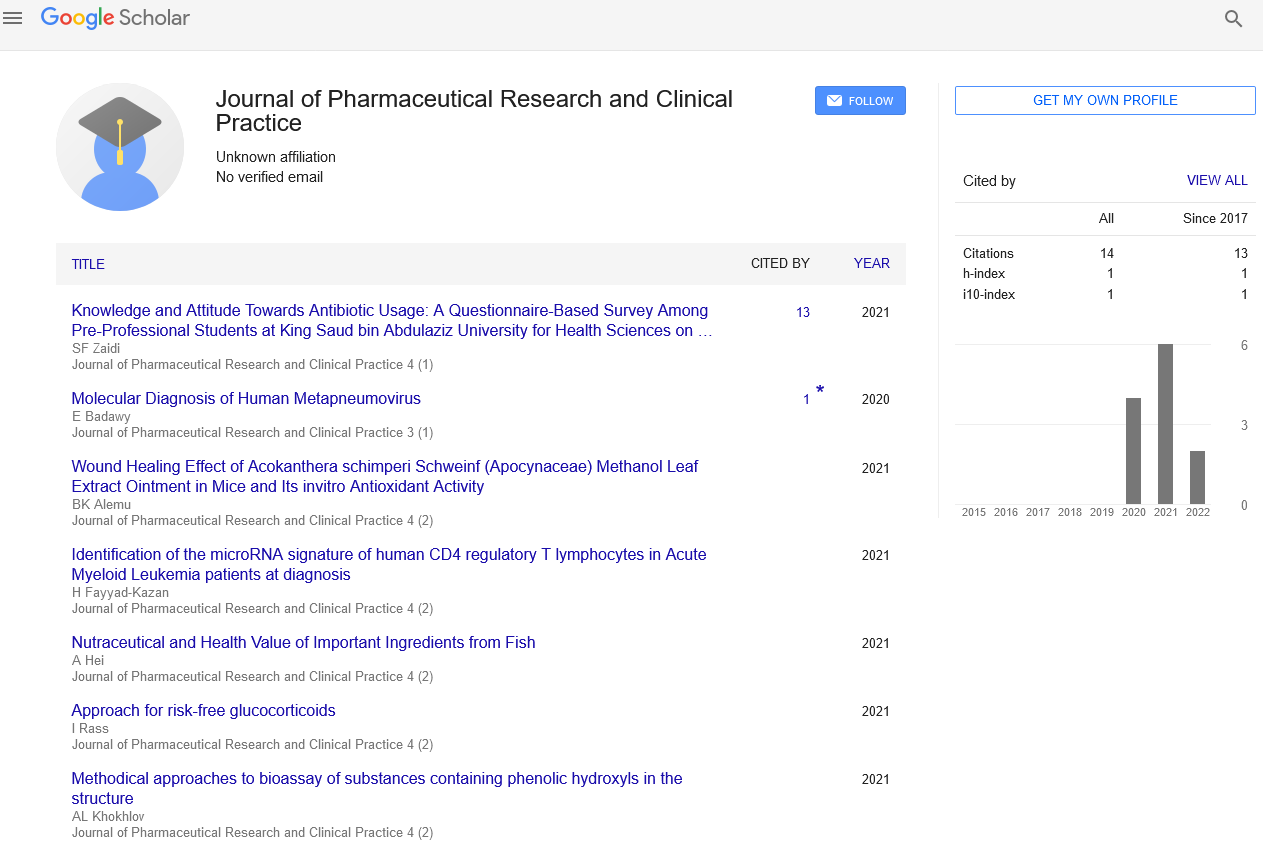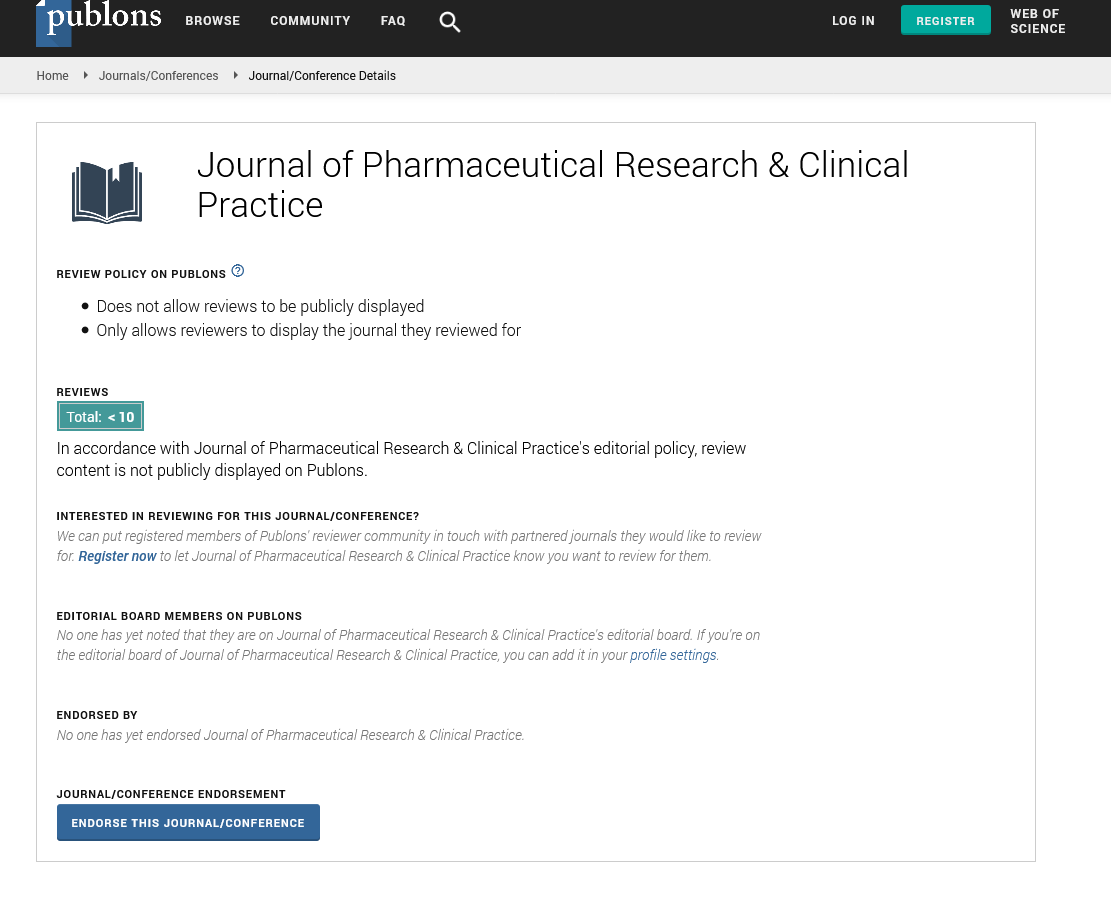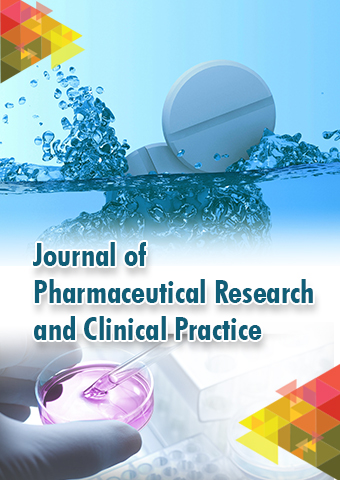Expert Review - Journal of Pharmaceutical Research and Clinical Practice (2023) Volume 6, Issue 1
A Prospective Study and Meta-Analysis of Fetal Stem cells Mesenchymal Stem Cell Implantable devices for the Cure of Inflexion Chondral Abnormalities
Snigdha Yadav*
Ipswich Hospital, East Suffolk and North Essex NHS Foundation Trust, Ipswich IP4 5PD, UK
Ipswich Hospital, East Suffolk and North Essex NHS Foundation Trust, Ipswich IP4 5PD, UK
E-mail: Snigdha_Y@gmail.com
Received: 01- February- 2023, Manuscript No. jprcp-23-88934; Editor assigned: 03- February- 2023, PreQC No. jprcp-23-88934 (PQ); Reviewed: 17- February- 2023, QC Nojprcp-23-88934; Revised: 22- February- 2023, Manuscript No. jprcp-23-88934 (R); Published: 28-February- 2023; DOI: 10.37532/ jprcp.2023.6(1).07-09
Abstract
Osteoarthritis is still a terrible long-term result of knee focal cartilage defects. It has necessitated the investigation of new treatments to regenerate cartilage before significant deterioration and subsequent joint replacement occur. It is associated with functional loss and pain. Polymer scaffold compositions and a wide range of mesenchymal stem cell (MSC) sources has been the subject of recent research. It is unclear how various combinations affect the quality of newly formed cartilage as well as the degree of integration between native and implant cartilage. In vitro and animal studies have largely demonstrated that implants seeded with bone marrow-derived MSCs (BMSCs) can restore these defects. Systematic review and meta-analysis to find studies that used BMSC-seeded implants in animal models of focal knee cartilage defects. The histological evaluation of integration quality’s quantitative results was extracted. The morphology and staining characteristics of the repaired cartilage were also recorded. In comparison to cell-free comparators and control groups, high-quality integration was achieved, as shown by meta-analysis. Repair tissue morphology and staining properties that were comparable to those of natural cartilage were associated with this. Studies that made use of poly-glycolic acid-based scaffolds had better integration outcomes, according to subgroup analysis. In conclusion, BMSC-seeded implants are promising options for improving the repair of focal cartilage defects. High-quality integration scores suggest that these implants could generate repair cartilage of significant longevity, despite the fact that a greater number of studies involving human patients are required to realize the full clinical potential of BMSC therapy
Keywords
Cartilage regeneration • Mesenchymal stem cells • Bone marrow • Implant • Scaffold • Cartilage-to-cartilage integration
Introduction
Osteoarthritis is a chronic condition characterized by the diffuse degeneration of articular cartilage in load-bearing joints, primarily affecting the elderly or obese. Another risk factor for the condition, which typically affects young, active patients, is the acquisition of focal cartilage defects from traumatic injuries. The majority of cartilage defects grow in size in otherwise healthy individuals, although a small percentage may improve [1].
These injuries put young patients at risk of needing an early joint replacement and multiple subsequent revision surgeries due to the fact that current, less invasive treatment options cannot ultimately prevent the requirement for a joint replacement. A method capable of preventing the progression of focal defects would be invaluable in light of the significant individual and organizational costs posed by knee arthroplasty and the projected rise in the incidence of revision surgeries. Cell therapies have emerged as a possibility for repairing cartilage tissue, which is wellknown for its lack of ability to regenerate. Matrix-induced autologous chondrocyte implantation (MACI) is approved for use in clinical settings on human patients and has demonstrated superior efficacy to other surgical procedures like mosaicplasty and micro fracture [2, 3].
Despite its effectiveness, the MACI method has some drawbacks. Mesenchymal stem cells (MSCs) may be able to overcome these issues. MSC therapy is a promising option for the future because of its lower cost, improved ability to proliferate in vitro and potential tendency to produce hyaline rather than fibrocartilage. The donor–site morbidity that is inherent in the MACI process, in which cartilage harvest precedes chondrocyte implantation at a separate site, is also reduced by its one-step procedure. Despite this potential, MSC therapy is still largely experimental and has not yet been used on humans [4, 5].
Discussion
The integration of regenerated and native cartilage has proven delicate to achieve, and yet it’s vital for the lifetime of form. This may be because the integration boundary remains the weakest point in the form towel, adding the liability of towel breakdown if integration is shy. BMSCs have shown encouraging primary integration results in creatures [6]. While the medium of cartilage – cartilage integration remains obscure, the paracrine goods of an extracellular matrix on chondrocytes and collagen cross-linking are considered applicable. Also affecting the lifetime of form is the morphology of the cartilage formed. The tendency of early surgical ways similar as micro fracture to produce fibrocartilage prodded the development of newer ways which may produce form towel more akin to native hyaline cartilage [7, 8]. Fibrocartilage is rich in type I collagen, low in proteoglycan content, and contains haphazard round cells, while hyaline cartilage is rich in both type II collagen and proteoglycan, with rounded chondrocytes divided into three zones of development. Safranin O and Toluidine blue stains both stain samples according to their proteoglycan content and are, thus, generally used in the assessment of cartilage form quality. As we set up preliminarily, mortal studies are doubtful to involve histological assessment of form towel rather, glamorous resonance imaging (MRI) is used as a high quality, non-invasive surrogate fashion to assess the morphology of the form, including border integration. As well as adding our understanding of the eventuality for BMSC- planted implants to yield integrated form towel, the focus on beast studies permits sapience into the histological assessment of form morphology. In summary, we aim to probe the degree of integrative form produced by BMSCs while also paying due attention to the quality of the form towel formed. Also, the composition of gels or pulpits varied between studies. Addict and co. Poly-(lactic-co-glycolic acid)( PLGA) and mongrel PLGA – GCH( gelatin, chondroitin, and hyaluronate) pulpits were directly compared. At 24 weeks, the time of the final immolation, integration did differ between the groups. When compared to the PLGA group, the integration quality of the PLGA- GCH group was superior. Although there was no statistically significant difference, the first cohort had significantly better integration than the empty control cohort [9]. That a sufficient number of studies estimated integration in a similar manner, making them suitable for altar type- grounded group analysis. PLGA- grounded pulpits displayed a statistically significant advantage (p = 0.001), as shown by the analysis. Despite the fact that including Zhou etal. Their disquisition into polyglycolicacid- hydroxyapatite (PLGAHA) pulpits revealed advanced integration when compared to the cell-free altar and empty control groups in group analysis. Still, there was no statistically significant difference between the two. The total histological scores, in addition to the scores for form towel morphology and staining characteristics, are shown. Morphology and matrix staining both showed trends that were analogous to integration. In all studies, BMSC interventions performed more than cell-free pulpits and empty controls. For four of the ten studies making this comparison, this difference was statistically significant. These scores also got better when cases had to stay longer after surgery. The remaining maturity of BMSC interventions constantly demonstrated superior total scores in comparison to cell-free interventions or controls, despite the fact that total histological scores were similar between two BMSC cohorts and their separate cell-free comparators. Six of the nine studies making this comparison showed that this difference was statistically significant. Again, as the time between the intervention and immolation grew, all studies revealed a sustained and bettered total score. Compared the performance of MSCs loaded onto a demineralized bone altar from colourful sources [10].
Conclusion
Twelve studies with quantitative results on histological outcomes after BMSC implantation were included. In general, BMSC-seeded implants integrated to a quality that was about average. Through meta-analyses, pooled integration scores indicated that more than one of the implant’s two sides successfully integrated with native cartilage. In addition, the integration scores of BMSC implants were higher than those of controls, cell-free implants, and MSCs from other sources. Serial measurements also showed that over time, integration quality got better. Interestingly, a statistically significant improvement in integration quality was found to be achieved using a PLGA scaffold over other implants.
In spite of these promising outcomes, it has been challenging to determine which implant engineering techniques are the most effective due to interventional heterogeneity—a problem that has been documented in the literature. In addition, if these animal studies are to ultimately guide human research and clinical practice, they must include long-term follow-up to determine the functional benefits of MSC implants.
After BMSC-seeded implants were used to fix focal cartilage defects in animal knees, the results of integration were compiled in this review. The integration of BMSC-seeded implants with the native cartilage was of high quality. Integrity research in animals provides a foundation upon which human BMSC-based treatment research can be informed. Additionally, we hope to reiterate the areas of future focus for optimizing this promising therapy. Standardization of methods to reduce heterogeneity, such as cell source, implant composition, and molecular characterization of MSCs, could be the focus of future research to determine the optimal combination of these various factors. A threepoint scale was typically used to evaluate integration quality: a) Integration of both edges, b) Integration of one edge, or c) Integration of neither edge. The number of points awarded (zero, one, or two) was determined by whether a higher or lower score was associated with a better or worse outcome. Meta-analyses combined the integration of regenerated and host cartilage outcomes when comparable scoring systems were used. We extracted total histological, cartilage morphology, and staining scores because we thought they were important to our understanding of the quality of cartilage repair. These assessments were qualitatively analysed for trends rather than pooled in met analysis due to variations in their recording.
Acknowledgement
None
Conflict of Interest
None
References
- Van den Anker J, Reed MD, Allegaert K et al. Developmental Changes in Pharmacokinetics and Pharmacodynamics.J. Clin. Pharmacol.58, 10-25(2018).
- Aagaard L. Off-Label and Unlicensed Prescribing of Medicines in Paediatric Populations: Occurrence and Safety Aspects. Clin. Pharmacol. Toxicol.117, 215–218(2015).
- Gore R, Chugh PK, Tripathi CD. Pediatric Off-Label and Unlicensed Drug Use and Its Implications.Curr. Clin. Pharmacol.12, 18–25(2018).
- Sketris, I.S.American Geriatrics Society Beers Criteria®Update Expert Panel. American Geriatrics Society 2019 Updated AGS Beers Criteria®for Potentially Inappropriate Medication Use in Older Adults.J. Am. Geriatr. Soc.67, 674–694(2019).
- Hill-Taylor B, Walsh KA, Stewart S et al. Effectiveness of the STOPP/START (Screening Tool of Older Persons’ potentially inappropriate Prescriptions/Screening Tool to Alert doctors to the Right Treatment) criteria: Systematic review and meta-analysis of randomized controlled studies.J. Clin. Pharm. Ther.41, 158–169(2016).
- Tommelein E, Mehuys E, Petrovic M et al. Potentially inappropriate prescribing in community-dwelling older people across Europe: A systematic literature review.Eur. J. Clin. Pharmacol.71, 1415–1427.
- Prot-Labarthe S, Weil T, Angoulvant F et al. POPI (Pediatrics: Omission of Prescriptions and Inappropriate prescriptions): Development of a tool to identify inappropriate prescribing.PLoS ONE.9,25-68.
- Corrick F, Conroy S, Sammons H et al. Paediatric Rational Prescribing: A Systematic Review of Assessment Tools.Int. J. Environ. Res. Public Health.17, 1473-1496(2015).
- Sadozai L, Sable S, Le E Roux et al. International consensus validation of the POPI tool (Pediatrics: Omission of Prescriptions and Inappropriate prescriptions) to identify inappropriate prescribing in pediatrics.PLoS ONE.15, 47-72 (2018).
- Barry E, Moriarty F, Boland F et al. The PIPc Study-application of indicators of potentially inappropriate prescribing in children (PIPc) to a national prescribing database in Ireland: A cross-sectional prevalence study.BMJ Open.8, 69-556 (2019).
Indexed at, Google Scholar, Crossref
Indexed at, Google Scholar, Crossref
Indexed at, Google Scholar, Crossref
Indexed at, Google Scholar, Crossref
Indexed at, Google Scholar, Crossref
Indexed at, Google Scholar, Crossref


